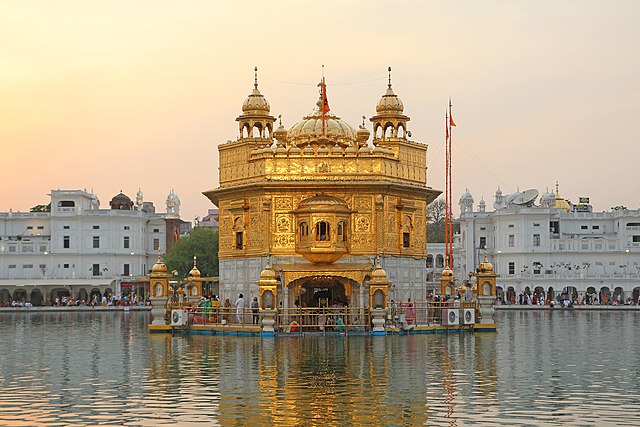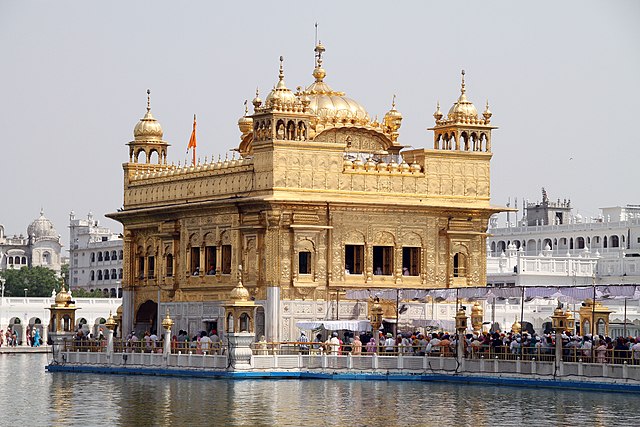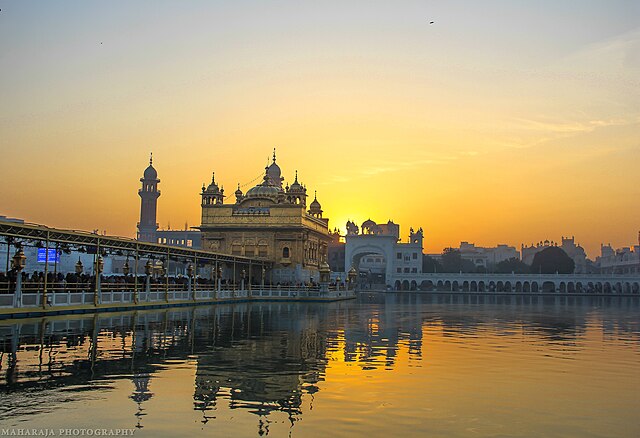Have you ever wondered what makes a place so sacred that millions of people from every corner of the world feel compelled to visit it? Harmandir Sahib, commonly known as the Golden Temple, isn’t just a religious site—it’s a living testament to human compassion, architectural brilliance, and spiritual devotion that transcends all boundaries.
Located in the heart of Amritsar, Punjab, this magnificent gurdwara stands as the most sacred shrine in Sikhism. But here’s what’s truly remarkable: you don’t need to be Sikh to feel the profound peace that washes over you the moment you step through its gates. The Golden Temple welcomes everyone, regardless of their faith, background, or beliefs.
What Makes Harmandir Sahib So Special?
Think of Harmandir Sahib as more than just a temple—it’s a symbol of equality, brotherhood, and divine love. Unlike many religious sites that face a particular direction, this golden marvel has four entrances, each facing a cardinal direction. This isn’t just architectural symmetry; it’s a powerful statement that God’s house is open to people from all walks of life.
The temple sits serenely in the middle of a sacred pool called Amrit Sarovar, connected to the mainland by a marble causeway. As you walk across this bridge, you’re not just moving from one physical space to another—you’re transitioning from the ordinary world into a realm of spiritual tranquility.
What strikes visitors most is the temple’s stunning golden facade that gleams brilliantly under the Punjab sun. But this isn’t merely about aesthetic beauty. Every golden panel, every intricate carving tells a story of faith, sacrifice, and unwavering devotion spanning over four centuries.
The Rich History Behind the Golden Walls

From Humble Beginnings to Sacred Ground
The story of Harmandir Sahib begins in the 16th century, but its roots go even deeper. Legend has it that this land was once a meditation spot for ancient sages. When Guru Ram Das Ji, the fourth Sikh Guru, founded the city of Amritsar in 1574, he chose this very location for its spiritual significance.
But why this particular spot? The area was believed to have healing properties, and the natural pool here was considered sacred long before the temple’s construction. Guru Ram Das Ji expanded this pool into what we now know as the Amrit Sarovar, meaning “pool of nectar.”
The transformation wasn’t immediate. It took vision, patience, and incredible dedication to turn this humble pool into one of the world’s most revered spiritual sites. The land was purchased from the local Zamindars, and the excavation of the sacred pool began—a project that would set the foundation for something extraordinary.
Guru Arjan Dev Ji’s Vision Comes to Life
Enter Guru Arjan Dev Ji, the fifth Sikh Guru, who had a revolutionary vision. In 1588, he began the construction of a temple that would break all conventional rules. Instead of building it on elevated ground like most temples, he chose to place it at a lower level, symbolizing humility before the divine.
Here’s where the story gets fascinating: Guru Arjan Dev Ji invited Mian Mir, a Muslim saint, to lay the foundation stone. This wasn’t just a gesture of interfaith harmony—it was a bold declaration that this sacred space would embrace all religions and all people. Can you imagine the courage it took to make such a statement in the 16th century?
The construction took several years, with craftsmen and devotees working tirelessly to bring the Guru’s vision to life. When the temple was finally completed in 1604, it wasn’t just a building—it was a revolutionary concept that would change how the world viewed religious spaces.
The Architectural Marvel That Defies Time
Why Gold? The Story Behind the Gilded Beauty
You might wonder why they chose gold to cover the temple. The gold plating wasn’t part of the original design—it came much later, in the early 19th century during Maharaja Ranjit Singh’s reign. But there’s deep symbolism behind this choice.
Gold doesn’t tarnish, doesn’t rust, and doesn’t lose its luster—much like the eternal truths that Sikhism teaches. The golden exterior serves as a metaphor for the purity and permanence of divine love. When sunlight hits those golden walls, it’s not just creating a visual spectacle; it’s reminding us of the inner light that exists within every human being.
The gold plating covers approximately 400 kilograms of pure gold, making it not just spiritually precious but materially invaluable as well. Yet, the true treasure lies not in the gold itself but in what it represents—the community’s collective devotion and the belief that nothing is too precious to offer to the divine.
Sacred Waters: The Amrit Sarovar
The pool surrounding the temple isn’t just decorative—it’s integral to the spiritual experience. The Amrit Sarovar covers an area of about 5.1 acres and is fed by underground springs. Devotees believe that taking a dip in these sacred waters can cure ailments and purify the soul.
But here’s what’s truly remarkable: the pool never dries up, regardless of weather conditions. Scientific studies suggest it’s connected to underground water sources, but for believers, it’s a miracle that reflects the inexhaustible nature of divine grace.
The marble walkway around the pool, known as the Parikrama, is where devotees circumambulate while reciting prayers. As you walk this path, you’re following in the footsteps of millions who have sought solace, healing, and spiritual connection in this sacred space.
Four Doors, One Message: Universal Welcome
The temple’s four entrances aren’t just about accessibility—they’re a profound theological statement. Each door welcomes people from every direction, symbolizing that spirituality knows no geographical, social, or cultural boundaries. Whether you’re coming from the north, south, east, or west, there’s a door waiting for you.
This architectural feature reflects the core Sikh principle of universal brotherhood. In a world often divided by differences, Harmandir Sahib stands as a beacon of unity, reminding us that we’re all part of the same human family.
The Spiritual Heart: What Happens Inside

Guru Granth Sahib: The Living Guru
Step inside the temple, and you’ll witness something extraordinary. The Guru Granth Sahib, Sikhism’s holy scripture, is treated not as a book but as a living Guru. Every morning, it’s ceremonially brought from its resting place and installed in the temple’s main hall with the same reverence you’d show to a beloved teacher.
The continuous recitation of hymns from the Guru Granth Sahib fills the air with divine vibrations. These aren’t just songs—they’re spiritual compositions created by Sikh Gurus and other saints, designed to elevate the soul and connect the human heart with the divine.
What’s fascinating is that these hymns aren’t exclusively Sikh compositions. The Guru Granth Sahib includes works by Hindu and Muslim saints, reflecting the inclusive nature of Sikh philosophy. When you listen to these recitations, you’re experiencing a truly interfaith spiritual symphony.
Daily Prayers and Ceremonies
The temple follows a strict schedule of daily prayers that begins before dawn and continues late into the evening. The day starts with Asa di Var, the morning prayer, around 3 AM, followed by various other ceremonies throughout the day.
But these aren’t somber, formal rituals. The atmosphere is filled with devotion, joy, and community spirit. Visitors often find themselves moved to tears, not from sadness but from the overwhelming sense of peace and connection they experience.
The evening ceremony, called Sukhasan, is particularly moving. The Guru Granth Sahib is ceremonially put to rest for the night, carried in a golden palanquin to its resting place. Witnessing this ceremony is like watching a community tuck their most beloved family member into bed with infinite love and care.
The Langar Tradition: Feeding Humanity
Perhaps the most remarkable aspect of Harmandir Sahib is its langar—the community kitchen that serves free meals to anyone who walks through its doors. And we’re not talking about a small operation here. This kitchen serves over 100,000 people daily, regardless of their religion, caste, creed, or economic status.
Think about that for a moment. In a world where people are often judged by their appearance, wealth, or social status, the langar creates a space where everyone sits on the same floor, eats the same food, and shares the same experience of community and equality.
The langar operates 24/7, with volunteers from all backgrounds working together to prepare, serve, and clean up after meals. It’s a beautiful example of seva (selfless service), where people contribute their time and energy not for recognition or reward, but simply because it’s the right thing to do.
Visiting Harmandir Sahib: Your Complete Guide
Best Times to Visit and What to Expect
Planning a visit to Harmandir Sahib? The temple is open 365 days a year, but some times are more special than others. The early morning hours, just before sunrise, offer a particularly serene experience. The golden reflection in the still waters, combined with the peaceful morning prayers, creates an almost mystical atmosphere.
Festivals like Guru Nanak’s birthday, Diwali, and Hola Mohalla see the temple at its most vibrant. During these times, the complex comes alive with additional decorations, special prayers, and larger crowds. However, if you prefer a quieter experience, weekday mornings are ideal.
The weather in Amritsar can be extreme, with hot summers and cold winters. The best months to visit are October through March when the weather is pleasant and comfortable for walking around the complex.
Dress Code and Etiquette: Showing Respect
Visiting Harmandir Sahib requires following certain guidelines, but these aren’t burdensome rules—they’re expressions of respect for the sacred space and the community that maintains it. You’ll need to cover your head (scarves are available at the entrance), remove your shoes, and wash your feet before entering the temple complex.
Modest clothing is expected—no shorts, sleeveless tops, or revealing attire. But don’t worry if you’re not prepared; the complex has facilities where you can borrow appropriate clothing. The emphasis is on showing respect, not on creating barriers to entry.
Photography is allowed in most areas, but there are specific guidelines to follow. The focus should always be on reverence rather than casual sightseeing. Remember, you’re not just visiting a tourist attraction—you’re entering someone’s home, someone’s most sacred space.
Photography Rules and Guidelines
While photography is generally permitted, it’s important to be respectful. Flash photography is not allowed inside the main prayer hall, and you should always be mindful of worshippers around you. The goal is to capture memories without disturbing the spiritual atmosphere.
Many visitors find that the most meaningful photos aren’t of the building itself but of the human interactions—the volunteers serving in the langar, the elderly devotees in quiet prayer, the children learning about their heritage. These images capture the true essence of what makes Harmandir Sahib special.
Beyond Religion: Cultural Impact and Legacy

Harmandir Sahib’s influence extends far beyond religious boundaries. It has become a symbol of Punjab’s rich cultural heritage and India’s diversity. The temple has inspired countless artists, writers, musicians, and filmmakers, becoming a recurring theme in Indian art and literature.
The architectural style of Harmandir Sahib has influenced gurdwara construction worldwide. From London to Los Angeles, Sikh communities have built gurdwaras that echo the design elements of their most sacred shrine, spreading its aesthetic and philosophical influence globally.
The temple has also played significant roles in various historical events, sometimes becoming a focal point for political movements and social change. Yet through all these challenges, it has maintained its core identity as a place of worship, service, and universal welcome.
Modern Challenges and Preservation Efforts
Maintaining a 400-year-old structure that receives millions of visitors annually is no small task. The temple management continuously works on preservation and restoration projects, using traditional techniques wherever possible while incorporating modern conservation methods.
Climate change, pollution, and the sheer volume of visitors pose ongoing challenges. The sacred pool requires regular cleaning and maintenance, the gold plating needs periodic restoration, and the infrastructure must be constantly upgraded to handle the crowds safely.
Technology has been embraced to enhance the visitor experience while preserving the temple’s sanctity. Live streaming of prayers allows devotees worldwide to participate virtually, and improved sound systems ensure that the sacred hymns can be heard clearly even in large crowds.
Why Harmandir Sahib Matters Today
In our increasingly divided world, Harmandir Sahib stands as a powerful example of what’s possible when we embrace our shared humanity. Its message of equality, service, and universal love resonates just as strongly today as it did four centuries ago.
The temple demonstrates that religious spaces can be forces for unity rather than division. Its open doors and free kitchen challenge us to think differently about hospitality, community, and our responsibilities to one another.
For millions of people, Harmandir Sahib isn’t just a place of worship—it’s a source of hope, a reminder that compassion and generosity can triumph over hatred and selfishness. In a world that often seems to celebrate differences as divisions, this golden temple reminds us that our differences can be sources of strength and beautiful diversity.
Conclusion
Harmandir Sahib is more than just a magnificent golden temple—it’s a living testament to the power of faith, community, and human compassion. From its humble beginnings as a sacred pool to its current status as one of the world’s most visited religious sites, it has consistently embodied the highest ideals of humanity.
Whether you’re drawn by its stunning architecture, its rich history, its spiritual significance, or its message of universal brotherhood, Harmandir Sahib offers something transformative to every visitor. It reminds us that in a world often divided by artificial barriers, there are still places where all are welcome, all are fed, and all are treated with equal dignity and respect.
The Golden Temple doesn’t just shine because of its gold-plated walls—it shines because of the golden hearts of the people who built it, maintain it, and keep its traditions alive. It stands as proof that when we open our doors and our hearts to others, we create spaces that are truly sacred.
Frequently Asked Questions
1. Do I need to be Sikh to visit Harmandir Sahib?
No, absolutely not! Harmandir Sahib welcomes people of all faiths, backgrounds, and beliefs. The temple’s four doors symbolize universal welcome, and millions of non-Sikh visitors come here annually to experience its spiritual atmosphere and cultural significance.
2. Is the langar (free meal) really free for everyone?
Yes, the langar is completely free for anyone who visits, with no questions asked about your background, religion, or financial status. The community kitchen serves over 100,000 people daily, operating 24/7 with the help of volunteers from all walks of life.
3. What is the best time of day to visit for a peaceful experience?
Early morning hours, particularly around sunrise (5-7 AM), offer the most serene experience. The temple is less crowded, the morning prayers create a deeply spiritual atmosphere, and the golden reflection in the water is absolutely breathtaking.
4. How should I dress when visiting Harmandir Sahib?
You must cover your head (scarves are provided), remove shoes, and dress modestly. Avoid shorts, sleeveless tops, or revealing clothing. The emphasis is on showing respect for the sacred space and the worshipping community.
5. Can I take photographs inside the temple complex?
Photography is generally allowed in most areas of the complex, but flash photography is prohibited inside the main prayer hall. Always be respectful of worshippers around you and remember that you’re in a sacred space, not just a tourist destination.

